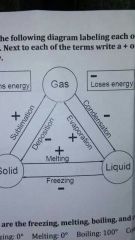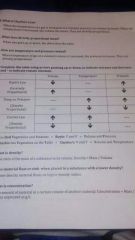![]()
![]()
![]()
Use LEFT and RIGHT arrow keys to navigate between flashcards;
Use UP and DOWN arrow keys to flip the card;
H to show hint;
A reads text to speech;
28 Cards in this Set
- Front
- Back
- 3rd side (hint)
|
Name the three ordinary states of matter. |
Solids, liquids, and gas |
|
|
|
How are the particles in a solid arranged? |
Closely packed, in fixed positions |
|
|
|
What is the difference between a crystalline and an amorphous solid? Give examples of both. |
A crystalline solid has particles arranged in a regular repeating pattern and melts at a specific temperature. ( like salt, snow, or sugar) An amorphous solid has no regular pattern to its particles, and does not melt at a specific temperature. ( like plastic or rubber) |
|
|
|
How are the particles in a liquid arranged? |
They are free to move but stay in contact |
|
|
|
What is a fluid? |
A fluid is a substance that flows. Both liquids and gases are fluids. |
|
|
|
What is surface tension? What causes it? |
The result of an inward pull among the molecules of a liquid that brings the molecules of the surface closer together |
Acting something like a skin |
|
|
What is viscosity? |
A liquids resistance to flowing. Its thickness. Liquids with high viscosity flow more slowly. |
|
|
|
How are the particles in a gas arranged? |
The particles spread out filling space available. |
|
|
|
Draw a table that shows the kind of shape and volume a solid, gas, and a liquid have. |
Solid have both definite shape and volume. Liquids have an indefinite shape and definite volume. Gases have both indefinite shape and volume. |
|
|
|
What is a change of state? |
A movement between states of matter. |
Such as water freezing to ice. |
|
|
Label the diagram of the six arrows with the change of state that occurs. |

|
|
|
|
What is the freezing point of water? |
O°C |
|
|
|
What is the melting point of water? |
0°C |
|
|
|
What is the boiling point of water? |
100°C |
|
|
|
What is the condensing point of water? |
100°C |
|
|
|
What are the particles of a solid doing as it reaches its melting point? |
Vibrating so fast they break free of their position. |
|
|
|
When does condensation occur? |
When the particles in a gas lose energy to become a liquid. |
|
|
|
What is sublimation? |
The changing of a solid to a gas without going through the liquid state. |
Like dry ice. |
|
|
What is pressure of a gas. |
The force of its outward push divided by the area of the walls of its container. |
Formula: Pressure =Force/Area. |
|
|
What is Boyle's Law? |
When the pressure of a gas are a constant temperature is increased, its volume deceases. When pressure decreases, volume increases. |
You can squeeze a gas. |
|
|
What does vary inversely mean? |
When one goes up and the other goes down. |
|
|
|
What is Charles's Law? |
When temperature of a gas is increased are a constant pressure, its volume increases. When the temperature is decreased, the volume deceases. |
Directly proportional |
|
|
What does directly proportional mean? |
When one goes up or down, the other starts the same. |
|
|
|
How are temperature and pressure related? |
When temperature of a gas at a constant volume is increased, the pressure increases. |
They are directly proportional. |
|
|
Complete this table using arrows pointing up and down, to indicate increase and decrease, and- to indicate remain constant. |

|
You boil= Boyle vegetables and potatoes. Boyle = V and P = Volume and Pressure. Charles has vegetables on the table= Charles's: V and T = Volume and temperature. |
|
|
What is density? |
The ratio of the mass of a substance of its volume. Density= Mass/Volume |
|
|
|
Does material float or sink when placed in a substance with a lower density? |
Lower density material floats on higher density matter. |
|
|
|
What is concentration? |
The amount of material in a certain volume of another material. |
Concentration = Mass/ Volume. Often expressed as g/L. |

